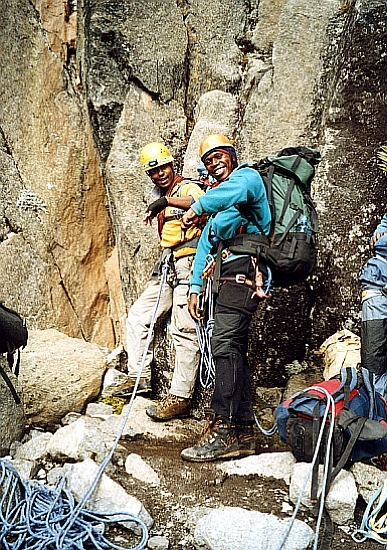At 5,199m high, Mount Kenya is the highest mountain in Kenya and the second highest in Africa. It offers different climbing routes up from easy to challenging ascents with superb scenic beauty.

Mount Kenya National Park is approximately 715 km² and protects the region surrounding Mount Kenya. It is approximately 150 - 175km's north-northeast of Nairobi.
Part of the mountain’s fascination is the variation in flora, including Giant Groundsel and Lobelia, and fauna as the altitude changes. The lower slopes are covered with dry upland forest, the true montaine (mountain) forest begins at 2,000m is mainly cedar and podo. At 2,500m begins a dense belt of bamboo forest which merges into the upper-forest of smaller trees, interspersed with glades. In this area the trees are festooned with high altitude lichen.
These forest belts are host to many different animals and plants with at least 11 unique species. Game to view includes: Black and White Colobus and Sykes Monkeys, bushbuck, Rock and rock Hyrax, Greater galago, white tailed, buffalo, elephant and lower down Olive Baboon, waterbuck, Black Rhino, black fronted duikers, leopard, giant forest hog, genet cat, bush pig and hyena. More elusive is the bongo, a rare type of forest antelope.
A number of other rarer species can be found here: Suni Antelope, Mt. Kenya Mole Rat, skinks (lizard), Montane Viper and a variety of owls. Occasional sightings have been recorded of albino zebra.
Birds are not abundant in the forest. But you can find Crowned hawk eagle and the Jackson's francolin. Rarely you can find the Abyssinian long-eared owl.
Birds seen form the lodge include; Green ibis, African black duck, Ayres' hawk eagle, Rufous-breasted and great sparrow hawks, Scaly francolin, Silvery-cheeked hornbill, Hartlaubs turaco, red headed parrot, bronze-naped pigeon, Mackinder's eagle owl, Rupells robin chat.
There are two species of giant Lobelias; the narrow, featherly-leafed lobelia telekii and the broad-leafed lobelia keniensis which are a favorite of sunbirds for their half hidden blossoms or the thin shelled snails that make their home there.
Plants also include crocus-like flower; Romuela keniensis, two terrestrial orchids - a Disa and a Habenaria, and an orange flowered gladiolus,Gladiolus Watsonioides.
The high altitude heath at the top (3,000 – 3,5000m) is generally open, dotted with shrubs: African Sage, protea and helichrysum. The peak (above 3,500m) is moorland, with little game other than high altitude zebra and eland, common in the northern moorland.
These forest belts are host to many different animals and plants with at least 11 unique species. Game to view includes: Black and White Colobus and Sykes Monkeys, bushbuck, Rock and rock Hyrax, Greater galago, white tailed, buffalo, elephant and lower down Olive Baboon, waterbuck, Black Rhino, black fronted duikers, leopard, giant forest hog, genet cat, bush pig and hyena. More elusive is the bongo, a rare type of forest antelope.
A number of other rarer species can be found here: Suni Antelope, Mt. Kenya Mole Rat, skinks (lizard), Montane Viper and a variety of owls. Occasional sightings have been recorded of albino zebra.
Birds are not abundant in the forest. But you can find Crowned hawk eagle and the Jackson's francolin. Rarely you can find the Abyssinian long-eared owl.
Birds seen form the lodge include; Green ibis, African black duck, Ayres' hawk eagle, Rufous-breasted and great sparrow hawks, Scaly francolin, Silvery-cheeked hornbill, Hartlaubs turaco, red headed parrot, bronze-naped pigeon, Mackinder's eagle owl, Rupells robin chat.
There are two species of giant Lobelias; the narrow, featherly-leafed lobelia telekii and the broad-leafed lobelia keniensis which are a favorite of sunbirds for their half hidden blossoms or the thin shelled snails that make their home there.
Plants also include crocus-like flower; Romuela keniensis, two terrestrial orchids - a Disa and a Habenaria, and an orange flowered gladiolus,Gladiolus Watsonioides.
The high altitude heath at the top (3,000 – 3,5000m) is generally open, dotted with shrubs: African Sage, protea and helichrysum. The peak (above 3,500m) is moorland, with little game other than high altitude zebra and eland, common in the northern moorland.
